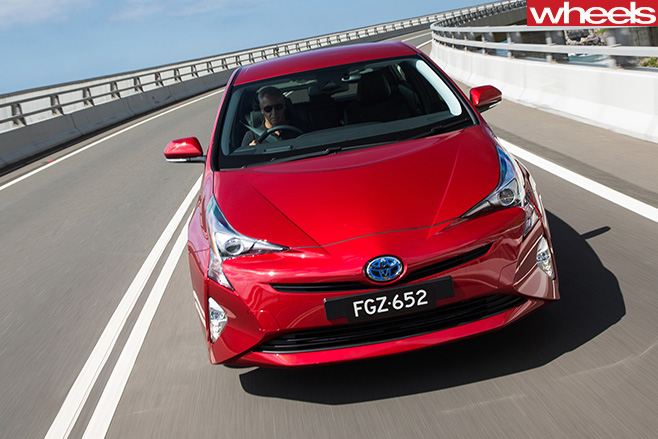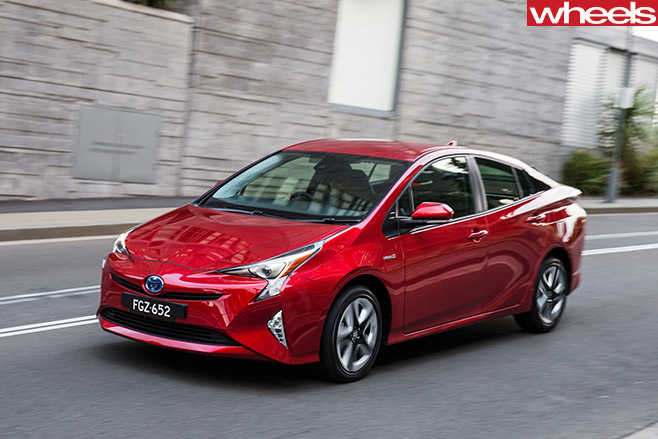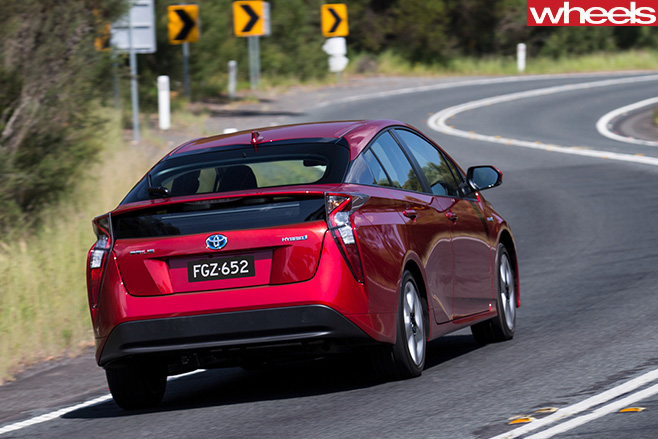The Toyota Prius, the car that introduced the world to affordable hybrid engine technology, has added newfound maturity.
WHAT IS IT? The fourth iteration of Toyota’s original hybrid car and the flagbearer of petrol-electric tech within the brand’s expanding hybrid range.
WHY WE’RE TESTING IT To see if the Prius can shake its stodgy driving image with an all-new model that’s actually claimed to be fun.
MAIN RIVALS Honda Civic Hybrid, Toyota Camry Hybrid and the upcoming Toyota Corolla Hybrid.

PLUS: Frugal hybrid drivetrain; classy interior; newfound maturity to driving dynamics MINUS: Rear headroom; still runs old school nickel metal hydride batteries despite being tech “ambassador”; no Apple CarPlay or Android Auto
THE WHEELS REVIEW MEET the Prius Toyota wants you to love – and not just for its ability to halve fuel bills. Toyota is so confident the fourth generation of the car that popularised petrol-electric propulsion will tickle the driving toes it guided media to a private test track to experience it under more extreme conditions – tyre squealing and all.
And that was after the snaking corners of the Old Pacific Highway and some of Sydney’s less forgiving suburban roads.
The verdict? It’s a huge step up for a Prius … but it’s no hot hatch.

The 15-inch Bridgestone Ecopia tyres on the base Prius lower grip levels slightly but are not as underwhelming as the look of the wheels they wrap.
Body control, too, is far more convincing and the Prius now deals admirably with B-grade roads, significantly improving comfort. It helps the driver is sitting low in the car – the front seats sit 55mm lower contributing to a centre of gravity that’s been reduced 24mm – so gets far less of the top-heavy lurching of previous Prii.
There’s still some inconsistency to the brake feel, and more so when you’re pushing on. On moderate applications the pedal is squidgy yet responsive. Throw the anchors out hard – as we did a few times on our track punt – and things get spicier as it swiftly approaches lock-up then eases off.

Floor it from a standstill and there’s a brief grumble as the petrol engine fires to life. Acceleration is respectable but far from fiery. Think Corolla or Hyundai i30.
Treat it more gently and the usable mid-range surge redeems points, which ensures respectable progress. And at any speed the extra work that’s gone into refinement is appreciated.
Fuel use is claimed at 3.4 litres per 100km, and our hundred-odd kays with the car would suggest you’d have to be leisurely with the right foot to get anywhere near that. But the 5.4L/100km we logged in occasionally spirited driving is excellent by any measure.
Inside, space is similar to Prius gen 3, with good leg room and loads of space up front, although rear seat head room is marginal for tall people.

The biggest change inside is to the presentation. The dash and controls have scrapped the scratchy, hard plastics of old models and adopted a more welcoming feel that looks vaguely upmarket. The central instrument cluster has a requisite high tech flavour, complete with a large digital speedo to complement the standard head-up display.
The base $34,990 Prius also gets bi-LED headlights with auto high beam, a reversing camera and a 10-speaker JBL sound system. Safety is taken care of with active cruise control, lane departure warning and auto emergency braking above 15km/h.
The i-Tech flagship ($42,990) has a mix of real and fake leather, sat-nav, digital radio tuning, front seat heaters, blind spot alert and rear cross traffic alert for reversing. Both versions use an old-school nickel metal hydride battery instead of a lighter, more compact and more expensive lithium ion one used for other world markets.
It adds up to a Prius that drives more like a tech leader should, but with the price premium attached to having a unique body in what is pitched as an ambassador for Toyota’s hybrid family.
SPECS Model: Toyota Prius Engine: 1798cc 4cyl with 53kW electric motor Max power: 90kW system power Max torque: 142Nm @ 3600rpm (petrol engine), 163Nm (electric motor) Transmission: CVT auto Kerb weight: 1375-1400kg 0-100km/h: NA Price: From $34,990





